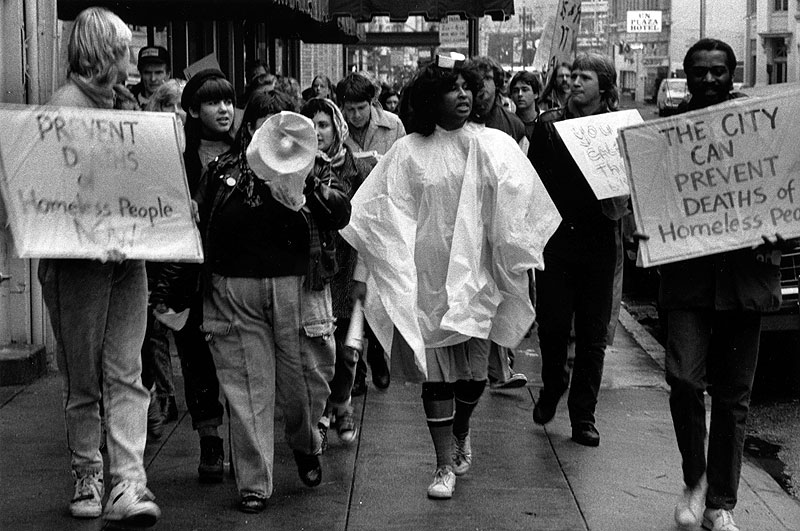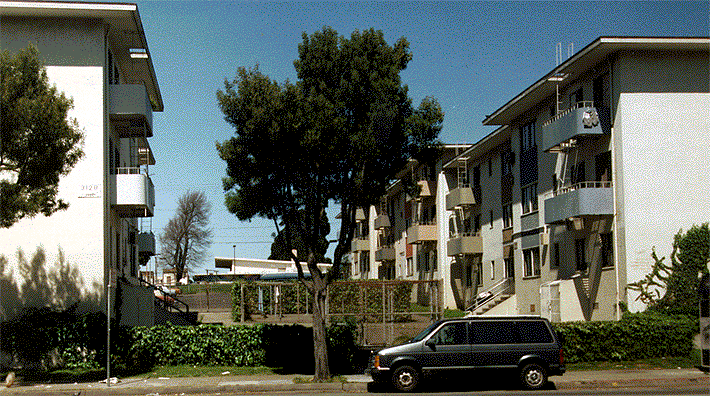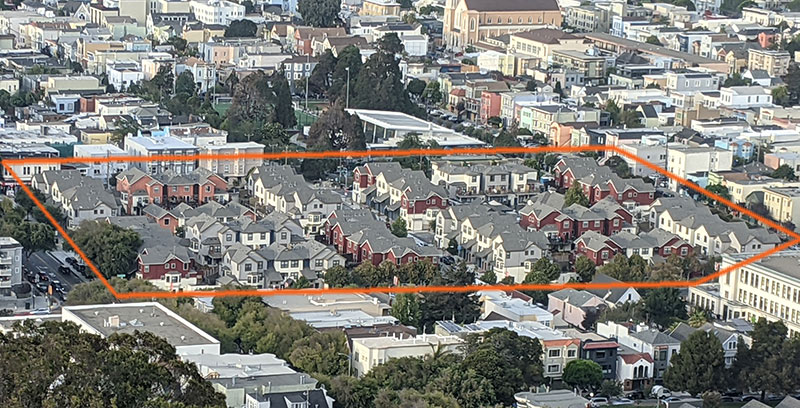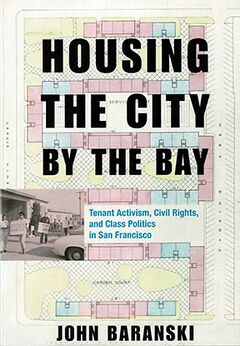Safety Net Torn Up by Government
Historical Essay
by John Baranski
This excerpt originally appeared in "All Housing is Public," Chapter Seven of Housing the City by the Bay: Tenant Activism, Civil Rights, and Class Politics in San Francisco (see below for copyright and book information)
Protest against deaths on the street of homeless San Franciscans, February 1989.
Photo: © Phil Head for the Tenderloin Times, courtesy San Francisco History Center, SF Public Library
Other neoliberal policies disciplined tenants in ways that made tenant organization and solidarity difficult. Instead of using in-house staff to evaluate applicants, the SFHA, like other housing authorities and private landlords, began to use tenant-screening companies that sold reports on an applicant’s credit, criminal, and renter performance histories. SFHA commissioners hired the National Tenant Network because, they claimed, an applicant’s background, especially in his or her “past performance in the rental market,” was helpful in determining if he or she was “a desirable public housing resident.”(95) Driven by profit and often unregulated in their behavior, companies such as the National Tenant Network were prone to mistakes and data-driven conclusions that did not account for human or computer errors or moral and ethical outcomes. Consequently, tenants could lose access to low-rent housing they had a right to receive. The contracting out of these kinds of government services often undermined the public sector and fiscal accountability.(96)
The rise of the prison industrial complex and the war on the poor also limited tenant organizing. Starting in the 1970s, a bipartisan push at all levels of government expanded the war on drugs and crime that put more people, especially the poor and nonwhite, in prison. For friends and family members of those charged or convicted of crimes, the financial and psychological burdens made life more difficult and could even impact their access to housing. HUD required housing authorities to evict a family if one of its members, or anyone who visited their home, committed a crime. For SFHA tenants, it meant that the criminal activities of “any tenant, or any member of said tenant’s household, or guests of tenant or some other person or persons under tenants control whether adult or minor” triggered an eviction. This one-strike rule aimed to reduce violent crime in communities, but it also expanded state power to discipline tenants who themselves had committed no crimes. The one-strike rule chipped away at the right to housing for members of qualified households.(97)
Federal and state legislation also began using “workfare” to push tenants who received government benefits into the labor market; more often than not, the work- fare program ended up punishing tenants more than helping them. In 1992, HUD San Francisco Regional Director Robert De Monte critiqued the workfare program championed by HUD Secretary Jack Kemp. De Monte thought that the “Secretary frequently makes the point that poverty should not be a crime,” and HUD “should remove the obstacles and disincentives to self help, schooling and employment.” However, De Monte pointed out that workfare programs, while successful in employing tenants, did not always benefit the workers. With the employment of tenants, he said, we “learn on frequent occasions the act of going to work reduces the residents disposable income. The San Francisco PHA has hired over 70 residents who on average lost over $100 per month by working.” De Monte thought this was “a case of defeating ourselves.”(98) HUD also increased the percentage that tenants had to contribute for HUD housing, from 25 percent to 30 percent of household income.(99) When Great Society community organizing money dried up, tenant organizing work fell on volunteers, who were often pulled in many directions—from dealing with friends and family in jail to having to work more for less. The cumulative ef- fects of these policies took away time and resources from tenants who had trouble volunteering in tenant organizations.
HUD neoliberal policies also targeted public housing authorities. In 1979, HUD began a performance-based evaluation, conducted by regional HUD offices, of the nation’s large public housing authorities. Known as the Public Housing Management Assessment Program (PHMAP), the evaluation covered broad areas such as physical quality of housing, financial and management effectiveness, and tenant–authority relations. Poor or failing scores triggered mandatory technical assistance and training, but sustained low scores landed a housing authority on HUD’s troubled housing authority list, which increased the likelihood of sanctions, reduced federal funding, and sometimes led to receivership.(100)
In 1984, HUD put the SFHA on the troubled housing authority list. From then to April 1989, the agency limped along with a series of interim directors until the SFHA hired David Gilmore to head the authority. Gilmore came fresh from Boston, where he had helped improve the performance of that city’s housing authority. He also served on Congress’s National Commission on Severely Distressed Public Housing. Gilmore’s main task at the SFHA was to remove the SFHA from the troubled housing authority list. To reach that goal, Gilmore lobbied HUD for monies, wrote grant applications, and addressed the SFHA’s most pressing problems: vacancies, unlivable units and uncompleted repairs, and overdue tenant accounts and uncollected rents. He developed a reputation for taking chances, saying “If you play it the safe way all the time and you cloak yourself in overwhelming concern about perception and how it may look, nothing ever happens. You don’t get anything done.”(101) Gilmore made a number of changes. He balanced the authority’s budget, paid off debt, and dropped the vacancy rate to less than 1 percent. He worked well with the SFHA labor force—hiring tenants and working with labor unions—and continued a legacy of affirmative action in hiring and in contracts.(102) HUD Regional Director Robert De Monte praised Gilmore, stating, “we, at HUD, are frequently in the role of critic of public housing authorities as the monitor. Now, I must say how impressed I am with your [work.] While in the business,” De Monte continued, “there are ever changing goals as we all strive to improve the quality of life for our mutual client. You and your staff are due a hearty congratulation. Keep the effort advancing.”(103)
In 1992, eighteen months after Gilmore’s arrival, HUD took the SFHA off of its troubled housing authority list and awarded a $49.9 million HOPE VI grant to redevelop two aging family projects—Bernal Dwellings and Yerba Buena Plaza East. As with the Rosa Parks project, the redesign of these two projects would be inspired by Newman’s defensible space and by New Urbanism’s emphasis on small developments within walking distance of people’s material and social needs. Drawing on “historic San Francisco Victorian townhouses,” designs for the Bernal Dwellings and Yerba Buena Plaza East had homes fronting old streets and even adding new streets that cut through the old super-blocks. The two- and three-story apartments would offer 50 to 300 more square feet per unit, with the total number of units falling from 208 to 160 at Bernal Dwellings and from 276 to 193 at Yerba Buena Plaza East. The designs planned for meeting spaces, youth centers, childcare centers, and even computer labs. At other SFHA projects, Gilmore allocated resources to do repairs, and he worked with the city’s police force to improve security.(104)
Bernal Dwelling at Folsom/Cesar Chavez/Harrison, here in 1996, rebuilt in the 2000s.
Photo: Chris Carlsson
Bernal Dwellings housing rebuilt into these townhouses, seen here from Bernal Heights in 2021.
Photo: Chris Carlsson
The future of the SFHA was looking brighter, but institutional and political challenges remained. There were many visible reminders of poor quality housing across the program, and the tenant associations remained fragmented. Many tenants had lost faith in the authority. In January 1992, Mayor Frank Jordan entered office ready to go after the authority and Gilmore. He had campaigned on a neoliberal promise to reduce the role of the SFHA in the city’s housing and to give tenants the opportunity for self-management and ownership. To Jordan, Gilmore did not move fast enough in these areas, was using his SFHA post to expand his political power, and was rebuilding the legitimacy of the SFHA. Because the SFHA was not a city agency, Jordan could not oust Gilmore, but he very publicly opposed the renewal of Gilmore’s contract in 1992.
Gilmore had the support of many in the SFHA community, including, importantly, the commissioners. Supporters came to Gilmore’s aid. At a packed June 11, 1992, SFHA meeting, former SFHA Commissioner Joan Byrnes San Jule commented that she was “awed by the tremendous progress made by the Commission and your very able Executive Director” and supported the extension of Gilmore’s contract. Others spoke favorably on his ability to work with tenants, unions, and public and private agencies in the city and in Washington, DC. Commissioners extended Gilmore’s contract and praised him, stating that his “stewardship of the Authority has been of the highest quality.” Gilmore expressed his gratitude to all in the meeting, saying “that today has been the highlight of my life.” He then issued
an open invitation to all those in attendance (supporters and non-supporters) to join the residents, staff and the rest of the city to work together to preserve public housing, which is “too precious a resource to go down the drain.”(105)
By the early 1990s, neoliberal policies made significant inroads in the nation’s political culture and public policies. These advances took a heavy toll on tenants, the nation’s public housing program, and economic and civil rights more broadly. HUD budget cuts, the trend of shifting public housing resources to the for-profit and nonprofit sectors, and new mechanisms to discipline public housing authorities and their tenants were among the ways public policies shaped how the SFHA operated. The problems of the SFHA, like those of other housing authorities, became more acute and visible, and those problems, from underfunding to rising crime rates, became an important part of the neoliberal narrative about the failure of government social programs. Public housing programs were also strained by inflation, by the increased demand for their low-rent housing, and by rising homelessness.
Yet the SFHA survived. Many of the city’s tenants and non-tenants still experienced the SFHA as “their” institution in their struggles for economic and civil rights and for a voice in the decisions that affected their homes, neighborhoods, and communities. Increasingly, local and national forces as well as internal problems in the tenant community reduced the remarkable degree of tenant solidarity that had been a hallmark of the 1960s and 1970s. This, in turn, reduced tenant power in and out of the city, marking the turn toward a more atomistic and individualistic tenant culture. The SFHA did not always meet the needs of tenants or the city’s residents; its program suffered from many of the same social, financial, and safety issues as other housing authorities.
The city’s residents nevertheless continued to view the SFHA as a vital, if less vibrant, part of their lives. At times, tenants and residents used the authority to exercise power and influence the decisions that affected their lives, housing, and communities. Sometimes they participated in national discussions and tried to influence directly national legislation. And they used the housing program to build a community based on their political interests as well as on their common experiences. In these ways, the SFHA program allowed ordinary people to put the public not only into public housing, but also into the workings of city politics itself.
previous article • return to part one
Notes
95. Quote in SFHA, Minutes (December 12, 1991). See exchange of letters between HUD San Francisco Regional Administrator Robert J. De Monte and others about tenant databases, Folder “1989 Chron File, R. J. De Monte,” Box 1, RH De Monte Reg. Administrator-RHC, 1988–1991, Program Files, RG 207, NARA/SB.
96. For a summary of problems resulting from contracting out, see Greenwood, “The Decision to Contract Out.”
97. SFHA, Minutes (March 22, 1990). The discipline even extended to SFHA employees with the Drug-Free Workplace Act of 1988. For the prison industrial complex, see Christian Perenti, Lockdown America: Police and Prisons in the Age of Crisis (New York: Verso, 2009); Michelle Alexander, The New Jim Crow: Mass Incarceration in the Age of Colorblindness (New York: New Press, 2012).
98. Robert De Monte email to Jack Kemp, William Dal, and Linda Marston (May 18, 1992), Folder “1992 Corres,” Box 1, Program Subject Files, R. H. De Monte, Regional Administrator, 1988–1992, NARA/SB, RG 207.
99. The rent increase happened over a five-year period for existing tenants, hitting 30 percent in 1985. All new tenants paid 30 percent after 1982.
100. U.S. General Accounting Office, “Information on Receiverships at Public Housing Authorities, GAO 303–363 a Report to Subcommittee on Housing, Committee on Banking, Housing and Urban Affairs, U.S. Senate” (February 1983); U.S. General Accounting Office, “HUD Should Improve the Usefulness and Accuracy of Its Management Assessment Program, GAO 303–363 a Report to Chairman, Subcommittee on Housing, Committee on Banking and Financial Services, House of Representatives” (January 1997); SFHA, Minutes (January 23, 1992).
101. For Gilmore background, see “Official Is a Player But Skirts the Rules—Housing Chief Cuts It Perilously Close to the Edge, Critics Say,” Seattle Times (November 3, 1994), and SFHA, Minutes (April 27, 1989). Quote in “Official Is a Player.” For the performance issues addressed by Gilmore, see SFHA, Minutes (January 23, 1992).
102. SFHA, Minutes (January 23 and June 11, 1992).
103. Quote in SFHA, Minutes (July 11, 1991). For optimism with Gilmore, see SFHA Minutes in 1991 and early 1992.
104. For an excellent account of these projects, see Larry Buron and Michael Baker, Abt Associates, Inc., “Interim Assessment of HOPE VI Program: Case Study of Bernal Dwellings and Plaza East in San Francisco, California, Final Report: Vol. 1” (March 2003), prepared for U.S. Department of HUD.
105. All quotes in SFHA, Minutes (June 11, 1992). SFHA, Minutes (January 23, 1992). For Jordan’s ideas, see his letter to SFHA Commissioner Barbara Meskunas (April 12, 1995), in SFHA, Minutes (April 13, 1995), and De Monte to Jordan (December 19, 1991).
Excerpted from Housing the City by the Bay: Tenant Activism, Civil Rights, and Class Politics in San Francisco by John Baranski, published by Stanford University Press. Used by permission. © Copyright 2019 by John Baranski. All rights reserved.




